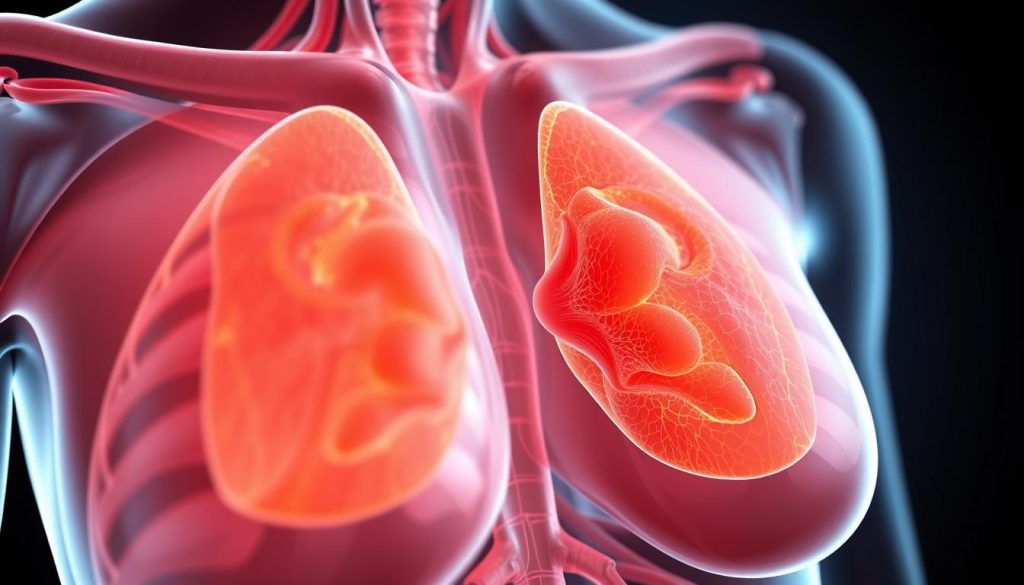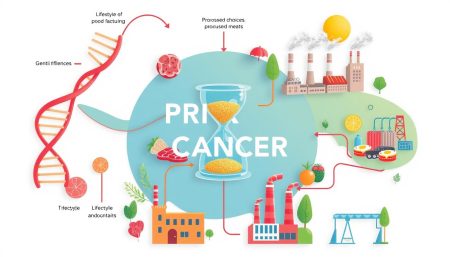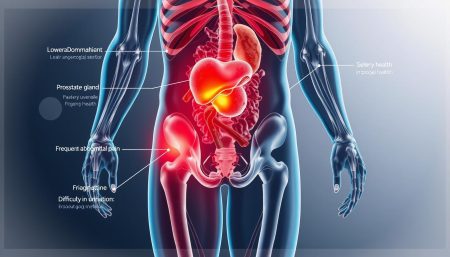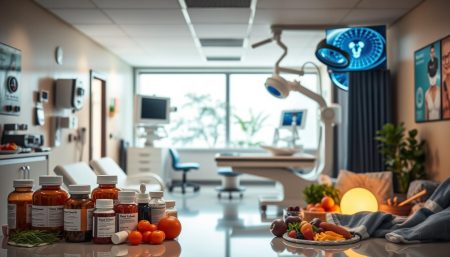Spotting breast cancer symptoms early can save lives. Not every change in breast tissue means cancer, but it’s important to pay attention. Look out for lumps and changes in skin texture, as these could be signs.
Early detection is key in fighting breast cancer. Regular self-exams and doctor visits help catch issues early. Knowing the common symptoms and when to see a doctor is a big step in keeping you healthy.
This guide will help you understand the important signs to look out for. It’s about knowing your body and trusting your feelings. If something seems wrong, don’t wait to talk to a doctor.
Understanding Breast Cancer Symptoms: A Guide
Breast cancer symptoms can be hard to spot, making it key to catch them early. Knowing what to look for helps you take care of your health. Let’s dive into the important parts of breast cancer awareness and prevention.
Why Early Detection Matters
Finding breast cancer early can greatly improve treatment results. Regular self-checks and screenings can spot problems early. This often means less invasive treatments and better survival chances.
Risk Factors and Prevention
Some risk factors you can’t control, but others you can. Age, genetics, and family history are part of it. But lifestyle choices also play a big role. Eating right, staying active, and not drinking too much can help lower your risk. Knowing these factors helps you make a plan to prevent it.
| Controllable Risk Factors | Uncontrollable Risk Factors |
|---|---|
| Obesity | Age |
| Alcohol consumption | Genetic mutations |
| Physical inactivity | Family history |
When to See a Doctor
If you notice any changes in your breasts, see a doctor right away. Lumps, skin changes, or nipple discharge need quick attention. Most breast changes aren’t cancer, but checking them out early is important for peace of mind and care.
- Persistent breast pain
- Changes in breast size or shape
- Dimpling or puckering of breast skin
- Redness or scaling of nipple or breast skin
By learning about breast cancer symptoms and taking action, you’re investing in your health and future.
Common Physical Changes in Breast Tissue
Breast tissue changes are a normal part of life. Understanding these changes can help you spot issues early. Let’s explore some common physical alterations you might experience.

Breast lumps are often the first thing people notice. They can range from small, pea-sized bumps to larger masses. Not all lumps are cancer, but it’s vital to have them checked by a doctor.
Texture changes in breast tissue are another important sign to watch. Your breasts might feel firmer or softer than usual. Some women describe it as a “thickening” of the tissue.
| Change | Description | Action |
|---|---|---|
| Lumps | Hard or soft masses in breast tissue | Consult doctor for evaluation |
| Texture Changes | Firmer or softer areas in breast | Monitor and report to doctor |
| Skin Dimpling | Puckering or indentation of breast skin | Seek immediate medical attention |
Remember, breast tissue can feel different throughout your menstrual cycle. It’s essential to become familiar with your normal so you can spot any unusual changes quickly.
Regular self-exams are key to early detection. If you notice any persistent breast tissue changes or a new breast lump, don’t hesitate to reach out to your healthcare provider.
Identifying Different Types of Breast Lumps
It’s important to know about breast lumps for early detection and peace of mind. Not all lumps are cancerous. Knowing the differences helps you get medical help quickly.
Benign vs. Malignant Lumps
Breast lumps are either benign or malignant. Benign lumps are not cancerous and feel smooth and rubbery. They move easily under the skin. Malignant lumps are hard, irregular, and don’t move.
Location and Texture Characteristics
The location of a lump can tell you about its type. Benign lumps usually appear in the upper, outer breast. They feel like a smooth marble. Malignant lumps can be anywhere, including near the armpit. They have a rough texture and feel hard and fixed.
Movement and Tenderness
Look at how a lump moves and feels. Benign lumps move easily and may hurt, like before your period. Malignant lumps don’t move and don’t hurt when pressed. Any new or changing lump needs a doctor’s check, no matter what it feels like.
| Characteristic | Benign Lumps | Malignant Lumps |
|---|---|---|
| Texture | Smooth, rubbery | Hard, irregular |
| Movement | Mobile | Fixed |
| Pain | May be tender | Usually painless |
| Location | Often upper, outer breast | Can be anywhere |
Visual Changes in Breast Appearance

Breast cancer symptoms often show up as changes in how your breasts look. Spotting these changes early can help get treatment sooner. It’s important to do regular self-exams to catch any odd changes in your breasts.
One sign to watch for is if one breast looks bigger or has a different shape. If your breasts don’t match like they used to, it could be a sign.
Skin changes on your breasts can also be a clue. Look for:
- Dimpling or puckering of the skin
- Redness or a rash-like appearance
- Thickening or swelling of breast tissue
- Orange peel-like texture (peau d’orange)
The area around your nipple can change too. If your nipple starts to pull in or flatten, it might be a sign of a problem. Also, watch for any scaling or flaking of the nipple skin.
Not every change means cancer. Many harmless conditions can also affect your breasts. But, if you see any lasting or worrying changes, see a doctor right away.
Understanding Nipple Discharge and Related Symptoms
Nipple discharge can worry many women. It’s not always a cancer sign, but knowing the types and when to see a doctor is key.
Types of Nipple Discharge
Nipple discharge can vary in color and texture. It might be clear, milky, yellow, green, or bloody. The color can hint at the cause.
| Color | Possible Cause | Concern Level |
|---|---|---|
| Clear | Normal breast changes | Low |
| Milky | Pregnancy or hormonal changes | Low to Moderate |
| Yellow/Green | Infection or cyst | Moderate |
| Bloody | Benign growth or cancer | High |
Associated Pain and Discomfort
Discharge can be accompanied by breast pain or tenderness. This pain can be mild or severe and may affect one or both breasts. If you have ongoing pain with discharge, see your doctor.
Normal vs. Abnormal Discharge
Normal discharge is clear or milky and happens in both breasts. Abnormal discharge is often spontaneous, from one breast, and may be bloody or have an unusual color. If you notice abnormal discharge, even with pain, get checked by your healthcare provider.
Skin Changes and Texture Variations
Breast cancer can cause noticeable skin changes and texture variations. These subtle changes in breast appearance often signal the need for medical attention. Being aware of these signs can lead to early detection and better treatment outcomes.
One common skin change is dimpling or puckering. This occurs when the skin pulls inward, creating a dent-like appearance. Breast redness is another warning sign. It may cover a small area or spread across the entire breast, often accompanied by warmth to the touch.
The “orange peel” texture is a distinctive skin change associated with breast cancer. This condition, known as peau d’orange, makes the breast skin look pitted and swollen, similar to an orange peel. It’s often a sign of inflammatory breast cancer, a rare but aggressive form of the disease.
| Skin Change | Description | Action Required |
|---|---|---|
| Dimpling/Puckering | Skin pulls inward, creating dents | Consult doctor immediately |
| Breast Redness | Red, warm areas on breast | Seek medical evaluation |
| Orange Peel Texture | Swollen, pitted skin appearance | Urgent medical attention needed |
Regular self-exams can help detect these skin changes early. If you notice any unusual alterations in your breast skin or texture, don’t hesitate to consult a healthcare professional. Early detection saves lives.
Recognizing Breast Pain and Tenderness
Breast pain and tenderness are common in many women. These feelings can be scary, but they don’t always mean cancer. Knowing the types of breast pain helps figure out when to see a doctor.
Cyclical vs. Non-cyclical Pain
Breast pain is divided into two types:
- Cyclical pain: Tied to hormonal changes during your period
- Non-cyclical pain: Not caused by hormones and might be more serious
Cyclical tenderness usually happens before your period and goes away after. Non-cyclical pain can be constant or change, and it needs more attention.
Location and Duration of Pain
The spot and how long you feel pain can tell a lot:
- Pain all over both breasts is usually cyclical
- Pain in one spot might mean a lump or problem
- Long-lasting pain over weeks should be checked
If you have sudden, sharp pain or tenderness, and skin changes like redness or swelling, see a doctor fast. Most breast pain isn’t cancer, but watching your breast health and telling your doctor about odd symptoms is key.
Lymph Node Changes and Their Significance
It’s important to know about lymph node changes to spot breast cancer early. Lymph nodes help our immune system fight off diseases. Swollen lymph nodes near the breast could be a sign of cancer.
Here are the main spots to look for swollen lymph nodes:
- Armpit (axillary lymph nodes)
- Above the collarbone (supraclavicular lymph nodes)
- Below the collarbone (infraclavicular lymph nodes)

To check for swollen lymph nodes, gently press the skin in these areas. Normal nodes are small and soft. If you find hard, fixed, or big nodes, see your doctor right away.
| Characteristic | Normal Lymph Nodes | Potentially Concerning Lymph Nodes |
|---|---|---|
| Size | Small (less than 1 cm) | Enlarged (greater than 1 cm) |
| Texture | Soft, flexible | Hard, fixed |
| Pain | Usually painless | May be painful or tender |
| Duration | Temporary swelling (e.g., during infection) | Persistent swelling (weeks or months) |
Swollen lymph nodes don’t always mean breast cancer. They can also swell from infections or other issues. If you notice lasting changes or have worries, get medical help. This way, you can get a proper check-up and early diagnosis of breast cancer symptoms.
Systemic Symptoms of Breast Cancer
Breast cancer symptoms can affect more than just the breast. It’s important to know these signs to catch the disease early. This helps in getting the right treatment quickly.
Unexplained Weight Changes
Weight loss without diet or exercise changes is a warning sign. Some women with breast cancer lose weight because of changes in how their body uses food. On the other hand, some gain weight due to hormonal changes or treatment side effects.
Fatigue and Energy Levels
Fatigue is a common symptom of breast cancer. It’s not just feeling tired after a long day. It’s a deep, lasting tiredness that doesn’t get better with rest. This fatigue can make everyday tasks hard and affect your quality of life.
General Body Changes
Other changes in the body may include:
- Skin changes like redness or thickening
- Bone pain or tenderness
- Shortness of breath
- Headaches or vision problems
These symptoms don’t always mean breast cancer. But, they should not be ignored. Early detection is key to saving lives. If you notice any lasting changes, see your doctor right away.
Monthly Self-Examination Techniques
Regular breast self-examination is key to catching breast cancer early. Doing these checks monthly helps you get to know your breast tissue. This way, you can spot any changes quickly.

- Visual inspection: Stand in front of a mirror with your arms at your sides. Look for any changes in breast size, shape, or skin texture.
- Raise your arms: Lift your arms above your head and check for any dimpling, puckering, or changes in breast contour.
- Lying down: Lie on your back and use your right hand to examine your left breast, then switch sides.
- Circular motions: Using the pads of your fingers, move in small circular motions from the outer edge of your breast toward the nipple.
- Varying pressure: Apply light, medium, and firm pressure to feel different breast tissue depths.
Make sure to check your whole breast area, including the armpit. If you find any lumps, changes in texture, or unusual discharge, call your healthcare provider right away.
| Self-Examination Area | What to Look For | Action if Found |
|---|---|---|
| Breast tissue | Lumps, thickening, or hardened knots | Consult doctor immediately |
| Skin | Dimpling, puckering, or redness | Schedule medical appointment |
| Nipples | Discharge, inversion, or scaling | Seek medical evaluation |
By making breast self-examination a part of your monthly routine, you’re taking charge of your breast health. This increases your chances of finding any problems early.
Advanced Screening Methods and Tools
Breast cancer screening has made huge strides. Now, we have advanced tools to find cancer early. These tools offer more than just self-exams, giving us a deeper look into breast health.
Mammogram Guidelines
A mammogram is a vital tool in breast cancer screening. Women aged 40-44 can start with yearly mammograms. From 45-54, yearly screenings are advised. After 55, you can switch to every other year. Discuss with your doctor what’s best for you.
| Age Group | Mammogram Frequency |
|---|---|
| 40-44 | Optional yearly |
| 45-54 | Yearly |
| 55+ | Every 2 years |
Ultrasound and MRI Options
Doctors also use ultrasounds and MRIs for screening. Ultrasounds are great for dense breast tissue. MRIs are often used for those at high risk. These tools can find issues a mammogram might miss.
- Ultrasound: Good for dense breasts
- MRI: Useful for high-risk patients
- Both: Can complement mammogram results
Early detection is critical. Regular screenings can save lives. Talk to your doctor about the best screening methods for you.
Risk Assessment and Family History
Understanding breast cancer risk factors is key for early detection and prevention. Family history is a big part of determining your risk level. If your close relatives have had breast cancer, your risk might be higher.

Genetic factors cause about 5-10% of breast cancer cases. Mutations in genes like BRCA1 and BRCA2 can greatly increase your risk. If these mutations are in your family, getting genetic testing is a good idea to check your risk.
Lifestyle choices also affect your breast cancer risk. Keeping a healthy weight, drinking less alcohol, and exercising regularly can lower your risk. Exposure to certain chemicals or radiation is another factor to consider.
There are tools to help you figure out your breast cancer risk. The Gail Model and the Tyrer-Cuzick Model are two common risk assessment calculators. They look at things like family history to guess your risk of getting breast cancer.
Having risk factors doesn’t mean you’ll definitely get breast cancer. Regular screenings and talking with your healthcare provider are key to managing your risk well.
When to Seek Immediate Medical Attention
It’s important to know when to get medical help for breast cancer symptoms. Some changes in the breast are not serious, but others need quick attention. Knowing the signs can help save lives.
Emergency Warning Signs
Some symptoms mean you should see a doctor right away:
- Sudden, severe breast pain
- Rapid increase in breast size or swelling
- Unexplained redness or warmth covering a large area of the breast
- Skin changes resembling orange peel texture
- Nipple retraction or inversion that occurs suddenly
Making Emergency Appointments
If you see any of these symptoms, here’s what to do:
- Contact your primary care physician or gynecologist immediately
- Explain your symptoms clearly, stressing their sudden or severe nature
- If you can’t reach your doctor, go to urgent care or the emergency room
- Bring a list of your current medications and medical history
- Don’t hesitate to seek medical help because of fear or uncertainty
Early detection and treatment are key to beating breast cancer. Trust your gut and get medical help quickly if you notice worrying symptoms.
Treatment Options and Next Steps
Getting a breast cancer diagnosis can be scary. But knowing your treatment options is key. Early detection helps a lot. Your doctor might suggest surgery, radiation, chemotherapy, or hormone therapy, depending on your case.
Surgery is often the first choice. It could mean removing the tumor or the whole breast. After surgery, radiation therapy kills any cancer cells left. For some, chemotherapy or hormone therapy might be needed to prevent cancer from coming back.
Every person’s fight against breast cancer is different. Your medical team will make a plan just for you. They’ll look at the cancer’s stage, your health, and what you prefer. Don’t hesitate to ask questions and lean on your loved ones for support.
Early detection is very important. Regular check-ups and self-exams can catch cancer early. This means more treatment options and a better chance of beating it. Always talk to your doctor about when you should get screened.
FAQ
Q: What are the most common early signs of breast cancer?
A: Early signs of breast cancer include a new lump or thickening. You might also notice changes in breast size or shape. Look out for skin changes like dimpling or redness.
Nipple changes, such as inversion or discharge, are also signs. Unexplained pain in the breast or nipple area is another warning.
Q: How often should I perform breast self-examinations?
A: Do breast self-exams once a month. Do them a few days after your period ends, when your breasts are less swollen. If you don’t menstruate, pick a consistent day each month.
Q: Are all breast lumps cancerous?
A: No, not all breast lumps are cancerous. Many are benign. But, it’s important to check any new or unusual lump with a healthcare professional.
Q: What’s the difference between normal breast changes and cancer symptoms?
A: Normal breast changes happen with hormonal shifts and are usually symmetrical. Cancer symptoms are persistent and affect one breast. They include sudden changes in appearance, texture, or sensation.
If unsure, always consult a healthcare provider.
Q: At what age should I start getting mammograms?
A: Women with average risk should start mammograms at 45, says the American Cancer Society. You can start at 40 if you want. Talk to your doctor about your risk factors for the best screening schedule.
Q: Can men get breast cancer?
A: Yes, men can get breast cancer, though it’s rare. About 1 in 833 men will get it in their lifetime. If you notice lumps or other changes, see a doctor.
Q: What should I do if I notice a change in my breasts?
A: If you notice unusual changes, see your healthcare provider right away. Many changes aren’t cancer, but early detection is key for treatment.
Q: Is breast pain a sign of cancer?
A: Breast pain is rarely cancer. Most pain is due to hormones or benign conditions. But, if pain is persistent or severe, check with your doctor.
Q: What are the risk factors for breast cancer?
A: Risk factors include being female and increasing age. Family history, genetic mutations, and early or late menstruation also increase risk. Dense breast tissue, radiation, obesity, alcohol, and lack of exercise are other factors.
Q: How can I reduce my risk of breast cancer?
A: You can’t change some risk factors, but you can lower your risk. Stay healthy, exercise, and limit alcohol. Avoid smoking, breastfeed if you can, and limit hormone therapy after menopause. Regular screenings and knowing your breast health are also key.
Q: What is nipple retraction and is it always a sign of cancer?
A: Nipple retraction means the nipple turns inward. It can be cancer, but it’s not always. Some people naturally have inverted nipples. If you notice a new change, see a healthcare professional.
Q: How does breast cancer affect lymph nodes?
A: Breast cancer can spread to lymph nodes in the armpit. Swollen or firm lymph nodes are a sign. Check the armpit area regularly during self-exams.


















